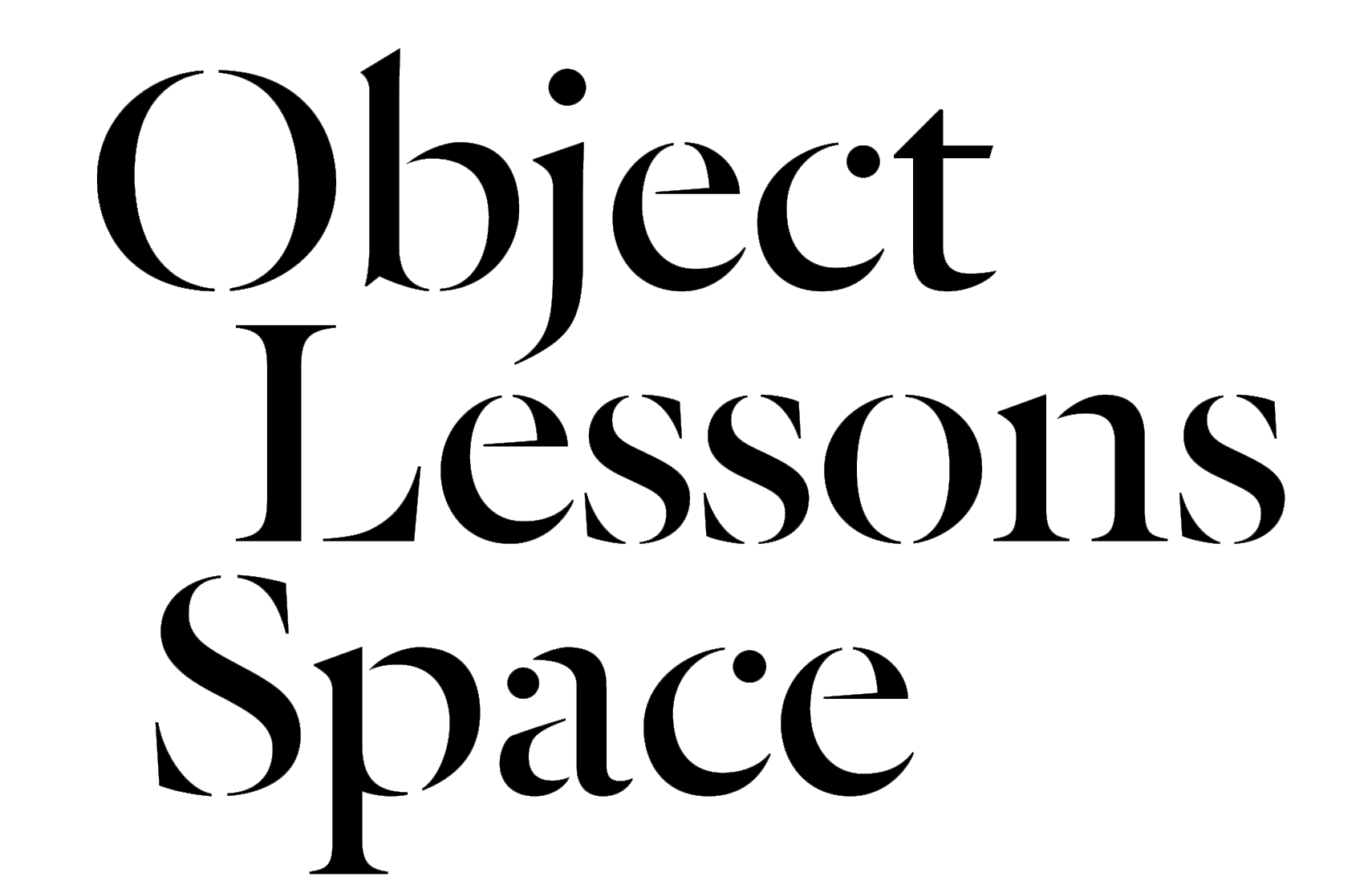Melati Suryodarmo’s (b. 1969, Indonesia) work deals with the relationships between the human body, the culture to which it belongs, and a constellation of the spaces it has inhabited. Melati Suryodarmo´s performances are concerned with cultural, social and political aspects, which she articulates through her psychological and physical body. Melati Suryodarmo studied at the Hochschule für Bildende Künste Braunschweig, Germany under Marina Abramovic. She has presented her works in various international festivals and exhibitions since 1996. She currently lives and works between Gross Gleidingen, Germany and Solo, Indonesia.
Known for her performative and durational works, Melati’s latest showing in Singapore is a body of works on paper. Made in close collaboration with the paper makers at STPI - Creative Workshop & Gallery over the course of a year, the works give an intimate look into the personal and built histories of abandoned spaces that are close to the artist’s heart. Throughout the course of this conversation, we chart some of the artworks that Melati has found interesting and inspiring and how she approaches the process of making art.
Known for her performative and durational works, Melati’s latest showing in Singapore is a body of works on paper. Made in close collaboration with the paper makers at STPI - Creative Workshop & Gallery over the course of a year, the works give an intimate look into the personal and built histories of abandoned spaces that are close to the artist’s heart. Throughout the course of this conversation, we chart some of the artworks that Melati has found interesting and inspiring and how she approaches the process of making art.


¹ The Arnolfini Portrait, Jan van Eyck
National Gallery, London, 1434
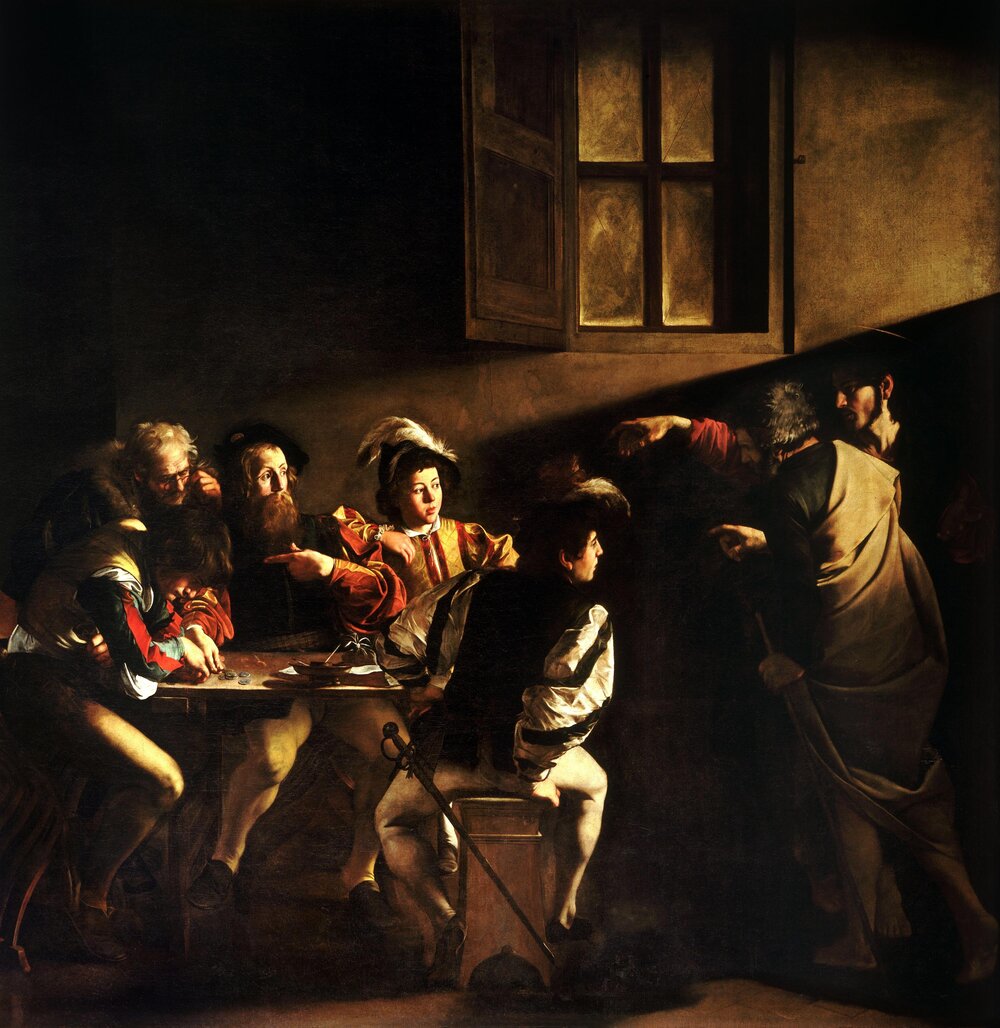
² The Calling of Saint Matthew, Michelangelo Merisi da Caravaggi, San Luigi dei Francesi, c. 1599–1600
Let’s start off with the fact that you picked out the works of Jan van Eyck and Caravaggio for our conversation. I think many of us associate their works with a very dramatic or cinematic quality. This comes through their use of colour, light, shadow, texture and forms. What draws you towards picking out works there so canonical to the study of art history?
I’ve always been interested in painting. I’m always impressed by the works of the European Old Masters, especially those who were active in the 16th and 17th centuries. I think that their works are timeless. I’m interested in the language they used to express themselves, even if it is through a simple gesture. This quality of timelessness is very important for me. If we say that a work is timeless, how did that come to be? As humans, we basically haven’t changed much. We've always been dealing with power, with love, with cruelty, with nature and our relationship to it, and even with God. But when you see works such as Caravaggio’s, and his dramatic use of light, it creates not just a particular atmosphere — it invites you to enter a dimension of historical time.
I was particularly interested in both of these artists because I was working on a performance work called Perception of Patterns in Timeless Influence. The subject of this work was societal trauma, and I did a lot of research into the history of my country. It all started, of course, when the missionaries arrived. Later when the Dutch East India Company (VOC) arrived, they began to occupy the entire Indonesian Archipelago. This went on for two hundred and fifty years. Just compiling a historical overview of all these years for an artwork is too simple, but I wanted to point at how much we’ve lost over this period of time. We lost a lot of the links or connections we have to our roots and our culture. It’s tough to recover from this, and then to go on from there to become an independent country. I consider this a building up of trauma, and this is carried from generation to generation.
In order to create this work, I was thinking about what happened in Europe during the 1600s. In that performance, I also used the music of Johann Sebastian Bach. I love Bach, and I always listen to St Matthew’s Passion. Now St Matthew’s Passion is another timeless work of art. Every time the aria sings the Blute nur, it makes me cry. There is some bitterness there, and of course there is. It is a story of love and betrayal. Even though I don’t subscribe to this religion, I’m still very moved by this piece of music. When you think about this, and the sort of works that Caravaggio and Jan van Eyck were making at that time, the colour red really stands out. As far as I know, there weren’t many European paintings produced before that period of time with such strong hues of red. Perhaps after half a century of trading with Asia, the brilliant red pigment managed to travel to Europe on these cargo ships as well. I think these paintings are fantastic in that they managed to capture events that were happening beyond the image itself. They managed to reflect what was happening at that point in time.
This is how I work. When I picked these works out, I didn’t mean to say that I work by drawing upon the techniques of painters such as Jan van Eyck or Caravaggio. I am inspired by their works, and they push me towards learning and finding out more.
³ Perception of Patterns in Timeless Influence, Melati Suryodarmo 2007, Performed at Lilith Performance Studio, Malmö, Sweden
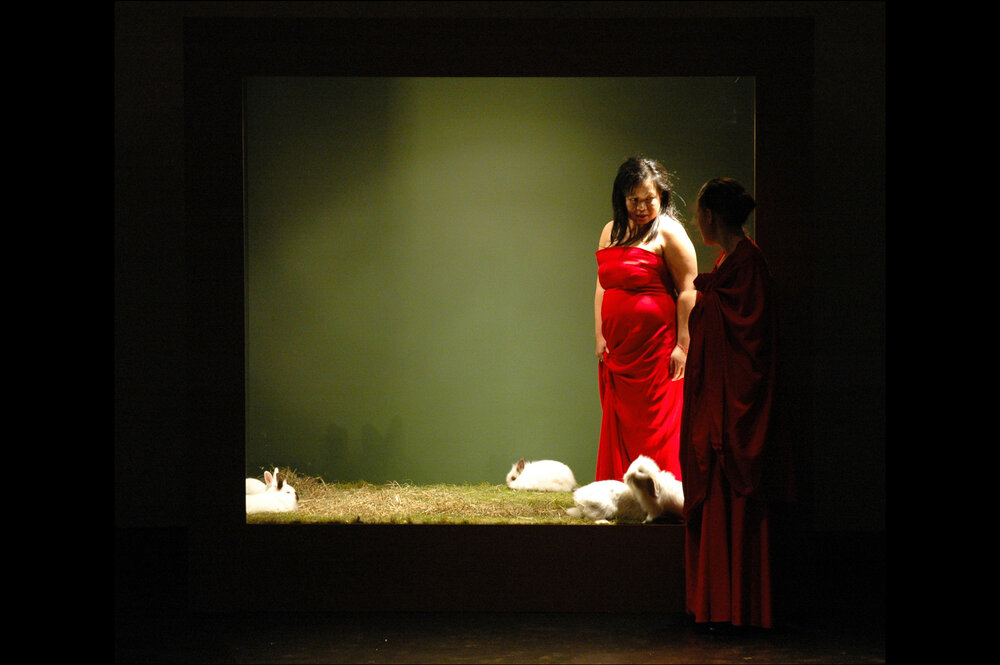

That’s a great opening into the body of work you are now showing at STPI. Here, you deal with the histories of places that you are familiar with but that are now left abandoned, unkempt and unruly. I understand that you collected some materials from these sites, and had hoped to incorporate them into making these works.
Could you talk us through this process of collecting and selecting materials, and how have you incorporated them into the works?
On my first visit to STPI during my residency, we did some local research. We started thinking through some possibilities. I learnt silkscreening, and discussed the technical aspects of working with paper.
When I came back the second time, I brought some objects with me. I wanted them to serve as a connection to my homes, and they referenced my interest in abandoned spaces and memory very clearly.
I even brought some objects from my father's house along. Some of these objects were purchased by my mother when I was child. There was a small bronze Buddha sculpture, for example, that I remember buying at an antique market with my mother when I was young.
Every house that my family has lived in is now gone. When I was doing research here into the Istana Woodneuk, I thought that maybe a piece of my personal story would fit into this work. However when we started the process of making, we soon realised that it wouldn’t work. We tried to make casts of these objects, but it did not work well. Nevertheless, it is good to have been through this process. Eventually, I thought to make paper casts that gave the impression of an archaeological find or imprint.
Something that emerges keenly in these works is its interest in exploring abandoned space. These spaces carry very layered and complex histories, which are sometimes very difficult to make sense of. Some of the works on display, for example the series with wisps of mulberry pulp delicately hang over paper casts, are visual representations of how these histories come to us in whispers. How did you begin approaching these histories, and composing works that would convey those murmurings?
The paper casts for those works were made from objects such as tiles, iron, part of the railings and the wooden floors — things that I thought were special or had value from my old homes. Alone, they weren’t enough. I didn’t want these works to just be archaeological. The mulberry pulp is the poetry. It grows with the object.
Mulberry has a sort of stretch when you carefully pull it apart. It hints at the absence of the object within the work. The object itself is only referenced. Although I could have taken the object itself and placed it in the work, the object, in and of itself, has no meaning. To cast it, and then to leave it as an imaginary form, was important to me. It references the house, the history of the house and the families that lived there.
Objects are witnesses to the people who live with them.
⁴ Various Works, Melati Suryodarm 2018, Installation View at STPI - Creative Workshop & Gallery
Photography: Toni Cuhadi © STPI
Photography: Toni Cuhadi © STPI


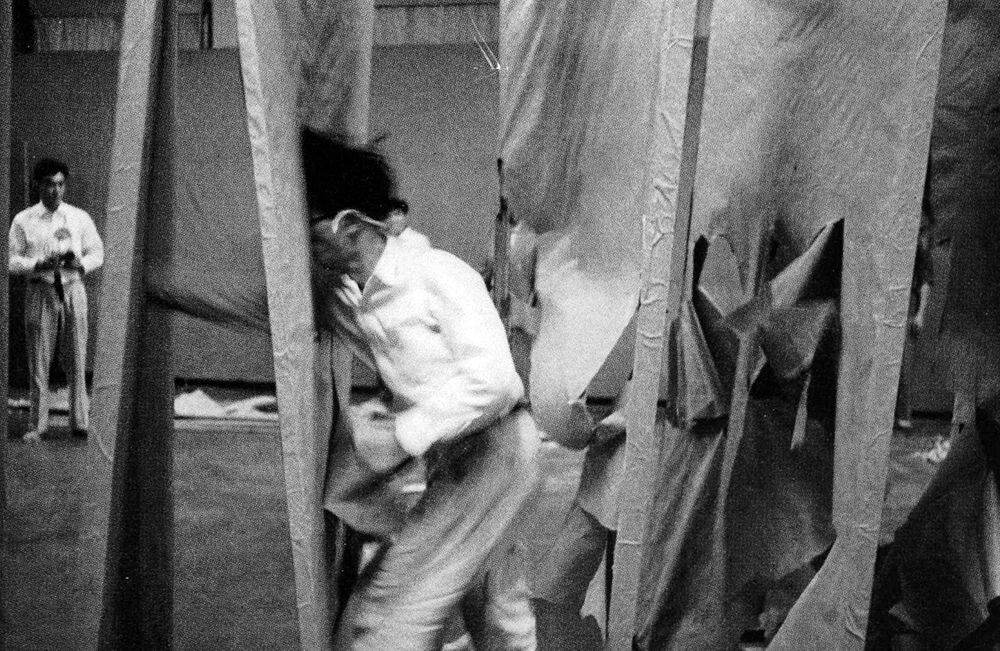
⁵ Laceration of Paper, Saburo Murakami, 1955
As someone who has moved around a lot and has lived in many countries before, this came through in your wide-ranging selection of works by artists such as Egon Schiele, Francis Bacon, the Gutai group and butoh. There is a very clear visceral and corporeal element that links all them together. As someone who works through and with bodily action, movement and energy, how have Western and Eastern philosophies shaped how you use your body in creating art?
I never think about the West or the East, really. When I look at this group of artists, what fascinates me is how these works twist. The animated expressions that you see in Schiele can also be found in butoh, particularly given the influence of German expressionist dance on the art form. The deconstruction of the natural body is, for me, very interesting. This kind of expression is the expression of imperfection, and I love that so much. It is not necessarily about becoming grotesque, although I do love the grotesque, but it is about the denaturalised body — and without going to the extreme, say, by referencing robots. I think it is interesting to deconstruct forms without ruining it.

⁶ Kneeling Girl, Resting on Both Elbows, Egon Schiele
Leopold Museum, 191
So a kind of contortion without mutation?
I’m really impressed and taken by this sort of art. For example, Schiele and his works were very controversial. Initially when I saw his works, I did not really understand why. But of course, he was touching on incredibly taboo topics. He was exposing the bodies of young girls. Yet putting artists like Schiele aside, I think it is important to recognise that girls do pose like this — with or without someone depicting them. Some of us like exploring our body. The ladies portrayed in Schiele’s works are not perfect, but I think that the imperfections within his works are what draw people in.
The issue of sexuality was also quite provoking for me. As a female artist who works with her body, this is often connected with notions of the body itself as an object. Why do we see a difference between male figures and female figures? Perhaps things have changed for the better in recent times, but it used to be the case that a nude female body was very different to a nude male one. I was thinking a lot about exposure and a photography series of mine. Acts of Indecency was inspired by gestures of Egon Schiele’s. In this series, I posed in a sensual manner but placed objects such as nails in my stockings. In doing so, the image becomes monstrous.

⁷ Set and costume for Parade, Pablo Picasso
1917
Let’s talk about your choice of Picasso as well. As an artist, his practice took many twists and turns. He is also a figure whose legacy we’re still trying to grapple with today. Is there a particular work of his, or a particular quality of his work that you particularly enjoy?
Have you heard of the work he did for the ballet, Parade? He created the set and costume design for that ballet, which was composed by Erik Satie.
⁶
Picasso is a pretty crazy guy, and when I picked him out for this interview, it wasn’t for his aesthetic. He invented movement. He embodies the spirit of freedom in a very classic sense. At the same time, he was also politically involved. Spain was ruled by a dictator at the time, and the Nazis were also making great headway in mainland Europe. He tried to include political statements within his art, and discussed political matters with fellow artists and friends.
That is what I find interesting about him — not, for example, his relationship to Cubism or Surrealism. He is free. I think if you speak about art as an expression of freedom, or that art should make you free, Picasso is an interesting figure that embodies that notion.
⁸ Various Works, Melati Suryodarm, 2018, Installation View at STPI - Creative Workshop & Gallery
Photography: Toni Cuhadi © STPI
Photography: Toni Cuhadi © STPI


On that topic of freedom, let’s turn the conversation to think about space again. Often when people think of space, they think of compartments or of confines. We've traveled around the world just talking about your selection alone, and obviously, space is something that is expansive, abstract and undefined. Personally when you think about space within your practice, what does it mean to explore space? How has that constant thought propelled you in your practice?
You can create space. Space is not just the physical. It can be transparent. Space is not always determined by lines and measurement. Space is where energy is accumulated. To me, where we’re sitting in now for this interview is not a space, although it technically can be defined as one. It simply is not a space that that I can engage with.
Ultimately, we should not separate ourselves or our presence from a space because there is a shared relationship.
When we consider space, another element that emerges naturally is that of time. Time is important to many of your walks, and we see that in the very durational quality of some of our performances. What is the significance of time to you? Particularly, I have in mind the pacing and the passing of time.
Time is meaningless if you don't think about it. Time is always going to be there anyway, but it has no value if we don't consider its existence. Doing performances over a long duration of time is important for me, because that allows me to melt down with time. It also charts how I change during the course of the performance. Obviously I have to set limits in place because of my own my physical limitations, but I don't like it when you go to am arts festival and they tell you that you only have a thirty minute slot for your performance. It’s very dictatorial, and it only allows you to create a limited piece. That works fine for certain contexts, but if I had things my way, I prefer to create performances that sit alongside time itself.
I want to let people get a sense of time itself, to see these changes, and to give people the space to experience time, or the time to experience space. It creates very luxurious moments, but my performances are only twelve hours long. We are dealing with, as you know, endless time. My performances cannot compare to those who work in an office, every day, for thirty five years. It is important that we see it in context of this, it becomes clear how performance holds a mirror up to our daily lives.
We are a part of this time-space continuum and are active participants within it. As someone who's very cognisant of how the body melts, as you say, in the face of time and working within a space, how has your understanding of your body evolved throughout your practice? Where do you stand now in that understanding, especially with regard to where the ties that bind time, space and body together coincide?
Performance art is, of course, always related to the body, time and space. For me, the preference is always to use my body. I’ve also tried borrowing other people’s bodies through choreography, for example. I’m currently in the midst of directing an opera. It has been difficult, but I’ve learnt so much about how to treat bodies. It is not just about the physical. I’m now interested in how using the body as an art medium relates to our life — our very liminal lives with our very sensitive reality.
Sometimes, it is a struggle for me to to work as a performance artist amongst a landscape of conventional visual artists. On other hand, this is the future. Just imagine — what if people become bored with materials and objects? What if we come to a point in time where working in a two-dimensional artistic medium becomes, for example, environmentally unsustainable? At that point in time, you only have your body. You can only do theatre or performance.
The body is a material that is very organic, and that is attached in a very direct way to real life. I'm sticking with it.
To detach myself from my work with this body of works of paper, and pushing myself to work with materials has been a very special experience. It has been very challenging as well, but I needed it. I need these kinds of experiences as well, because it is interesting to see what happens when I am detached from the artwork. Most of the time, I am the artwork. This time I’m detached, like so many other artists, and it feels different. Having said that, I think it works. With the conceptual focus of these works, I think my presence is still there — but in a very different way.
⁹ Various Works, Melati Suryodarm, 2018, Installation View at STPI - Creative Workshop & Gallery
Photography: Toni Cuhadi © STPI
Photography: Toni Cuhadi © STPI
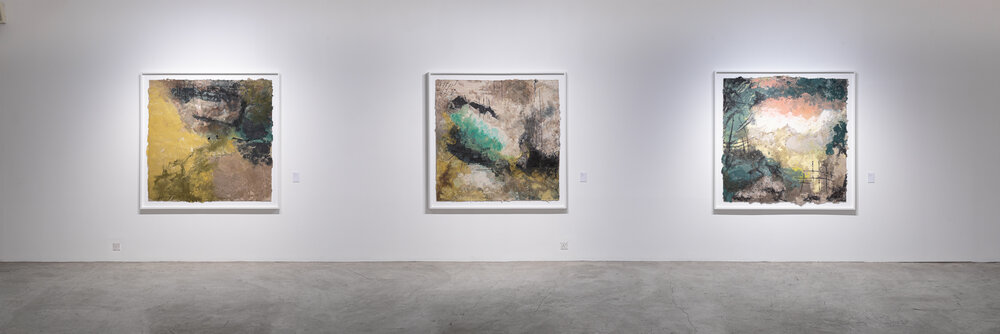
Memento Mori is now open. The exhibition will run at STPI - Creative Workshop & Gallery until 24 January 2020. More information about the exhibition can be found here.
